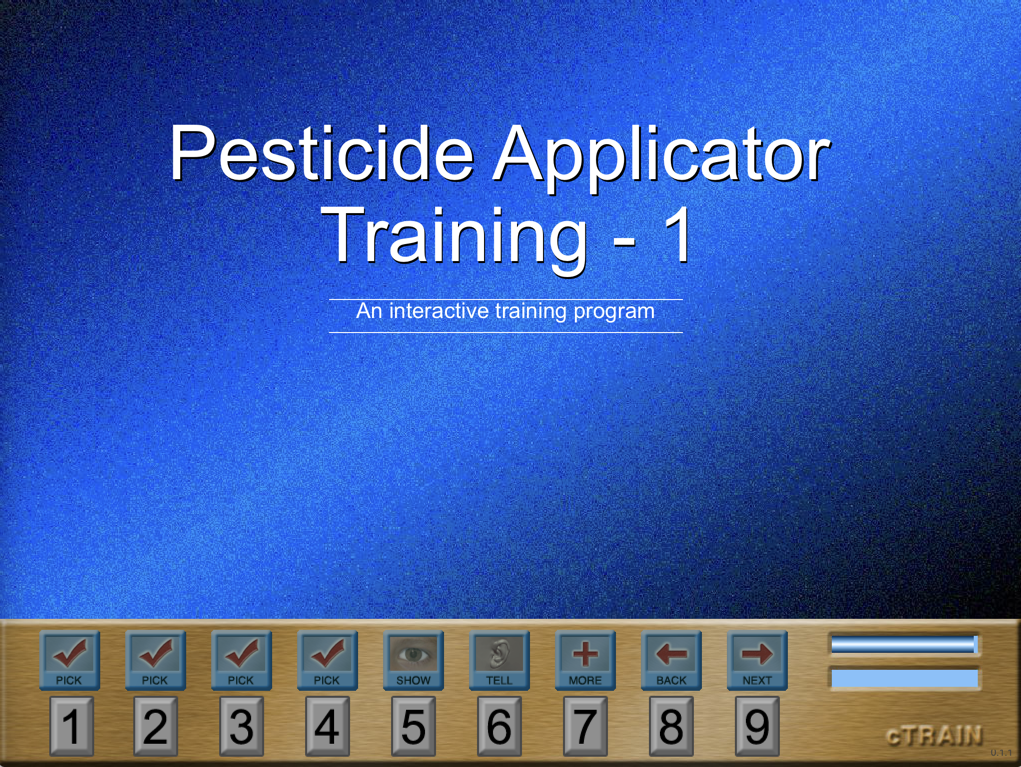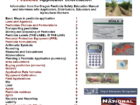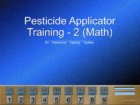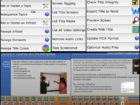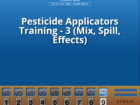Description
Teaches the fundamentals of becoming a pesticide applicator in Oregon (Part 1 of 4). Topics:
Goals of the training:
• How a pesticide applicator approaches an application site
• How this training program is organized
• Materials you need to complete this training
Organisms that damage plants
• Weeds and how to identify them
• Pest Controls
• Types of pesticides and what they are used for
• Integrated Pest Management
Personal Protective Equipment (PPE)
• Gloves
• Respirators
Types of formulations and their abbreviations.
• How to choose the best formulation and when to use it
• Dangers of these formulations and the steps to take to protect yourself
Part 1 of Pesticide Applicator training consists of 687 screens (the Spanish version has 689 screens).
Evidence base: The four pesticide applicator training titles (parts 1-4) designed to teach applicators to acquire knowledge and skills to be an effective applicator and to complete a licensing exam (Oregon example) were completed by 14 male vineyard workers 13 of which sought to become applicators (one was an applicator taking the training as a refresher). All 14 were born in Mexico, reported a mean age of 31.7 and reported an average of 6.5 years of education (range 0-12 years, all in Mexico). All participants completed the training over a 1-week period in a classroom setting overseen by Dr. Anger’s lab. Their knowledge scores were, respectively on the post-tests in Part 1: Laws, regulations, registration: 85%; labels interpretation 88%; Part 2: Equipment calibration, application calculation: 77%; Formulations and toxicology: 92%; Part 3: Mixing/loading, storage and safety: 92%; Management and environment: 86%; pesticide characteristics: 88%). At the end of Parts 1-3, a 100-question pesticide application practice test (Part 4) was administered, in which the information learned had to be applied to new labels only in English; percent correct performance was 49%. This led to repetition of the training topics that had the lowest Part 4 test performance for each participant, information that can be found in the tag reports for Parts 1-3. Feedback from participants indicated that having labels in Spanish for the Part 4 test would have improved performance considerably, but the state certification tests are based on predominantly available labels which are in English. Participants indicated that they liked the training and their confidence increased for performing applicator procedures and to take a licensing exam. Dr. Kent Anger’s laboratory conducted this pilot study and complied the results. They have not been independently peer reviewed.
Record of Results
Licensing provides an account, password option and secure server space where all results are saved in your organization’s space; results can be downloaded through our Data Reports tool (free).
Notes
• Trainings (licensed ‘uses’) can begin at any time over a year from the initial date on the license.
• Once a training is begun there is no time limit on when it can be completed.
• Users can quit the training (press esc or close browser) and click the original link to return to the same place in the training if they use the exact same user name that they entered when starting training.

